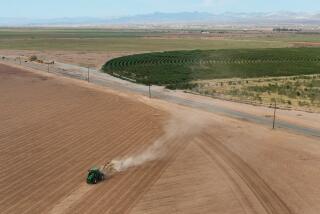Forecast of Drier Winter Is Relief for Farmers, Agencies
- Share via
Last year they met her temperamental brother, who wrecked piers and washed out crops. Now firefighters, flood-control workers and farmers are happy to see La Nina, El Nino’s more sedate sister.
La Nina, the bookend opposite to the weather phenomenon known as El Nino, is expected to bring a drier, slightly warmer-than-average winter in Southern California. Her more irritable brother was known for abnormally wet and cold weather that flooded reservoirs in Ventura County and destroyed crops.
In Southern California, meteorologists downplay the effect that La Nina is expected to have on this year’s rainy season. Precipitation will be about 70% of normal and temperatures slightly above normal, they say.
That forecast is a relief for agencies and others overwhelmed by last year’s weather, when Ventura County averaged 250% more rainfall than normal.
Among farmers, strawberry growers should be happiest about this winter dryness, according to Alan Laird, Ventura County’s deputy agricultural commissioner. Their sensitive crops were hammered hardest by El Nino’s rains, while tree-grown crops mostly benefited from the extra precipitation.
The first crop of strawberries, which will appear in December and carry a higher market price, could benefit from less water, more so than berries grown later in the season.
“If you’re a strawberry grower, that’s not that bad of a forecast to have La Nina instead of El Nino,” Laird said.
Even with rainfall expected to be below normal, there is no need to worry about drought. “The reservoirs are indeed full and we’ve got carry-over storage even over into next year,” said Don Kendall, general manager of Calleguas Municipal Water District, which provides water to about 75% of county residents.
Kendall said the water district has stored water in the North Las Posas Basin and Lake Bard. More water is also stored in state facilities.
With fire season continuing into November, the Ventura County Fire Department remains on alert, even with more moisture than normal in brush and the atmosphere.
“That’s a plus for firefighters,” department spokesman Joe Luna said.
There is still enough moisture left from El Nino that firefighters had a hard time completing a prescribed burn Wednesday, Luna said. Firefighters are making no special provisions to cope with the drier weather La Nina may bring, he said.
El Nino conditions occur when trade winds weaken, allowing a pool of warm water to stretch east across the Pacific along the equator. Evaporating water puts more moisture into the air and storm tracks dip farther south than normal, producing stormy, wet weather in California.
La Nina conditions occur when stronger than normal trade winds blow west from Peru, piling up warm water along the equator on the other side of the Pacific. In turn, cold, nutrient-rich water from the depths rushes in to fill the void.
The two climatic siblings often go hand-in-hand. After a year of wetter-than-normal weather caused by El Nino’s warming of the ocean, La Nina cools down the waters and dries things out.
“Not every El Nino is followed by La Nina, but generally it does happen,” National Weather Service meteorologist Bruce Rockwell said.
Since June, a band of water slightly cooler than normal has been building from the central Pacific nearly to South America. It will grow larger and colder in the next few months, said Gerald Meehl, atmospheric scientist at the National Center for Atmospheric Research in Colorado.
Those conditions force storms to track farther north and make less moisture available to fronts that reach Southern California, according to Art Miller, associate research oceanographer at the Scripps Institution of Oceanography in La Jolla.
The result should be a drier, slightly warmer winter in the southern half of the United States. Wetter cold weather should return to the northern states. The Atlantic and Gulf coasts may get more hurricanes. India, Indonesia and the Philippines can expect heavy rains, scientists say.
But scientists are hedging their bets because La Nina’s behavior is more unpredictable, natural forces are still building it, and it has not been studied in as much detail as El Nino.
El Nino and La Nina are not new phenomena, as the glut of media coverage of them might suggest. Ocean waters have shifted temperatures since the earth’s beginning, but until recently climatologists lacked the technology to recognize and track the shifts.
(BEGIN TEXT OF INFOBOX / INFOGRAPHIC)
Annual County Rainfall
Here are rainfall figures for the 1997-98 rain year, which ended Sept. 30. Also shown are rainfall records and the year in which they occurred.
*--*
Rainfall Percent of since normal Maximum Rainfall Location Oct. 1, 1997 rainfall Year amount Camarillo 34.98 269% 1941 33.43 Casitas Dam 59.12 257% 1983 51.13 Casitas Rec. Center 55.70 245% 1978 49.66 El Rio 39.73 268% 1978 33.36 Fillmore 45.66 248% 1983 42.30 Matilija Dam 64.19 243% 1969 70.04 Moorpark 34.95 240% 1983 32.48 Oak View 54.27 248% * * Ojai 45.53 230% 1978 48.60 Upper Ojai 54.25 233% 1969 56.58 Oxnard 36.73 256% 1941 38.17 Piru 38.98 229% 1983 40.36 Port Hueneme 34.12 247% 1941 32.99 Santa Paula 44.77 260% 1983 38.03 Saticoy 45.73 296% * * Simi Valley 37.20 260% 1983 35.06 Thousand Oaks 33.28 219% 1983 32.75 Ventura 38.53 272% 1941 36.71 Ventura Govt. Center 42.46 269% 1941 39.95
*--*
* Maximum rainfall amounts not available for all locations
Source: Ventura County Flood Control District
More to Read
Sign up for Essential California
The most important California stories and recommendations in your inbox every morning.
You may occasionally receive promotional content from the Los Angeles Times.













